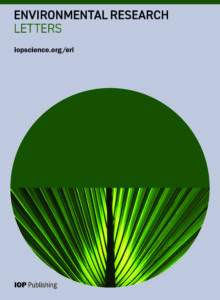ERL特刊征稿|Atmospheric Remote Sensing and Environmental Change

特刊详情
客座编辑
- 李正强,中国科学院空天信息创新研究院
- Jason Blake Cohen,中国矿业大学
- 秦凯,中国矿业大学
- 林金泰,北京大学
- 姜哲,中国科学技术大学
- 金晓梦,美国罗格斯大学
主题范围
This focus issue aims to broadly solicit studies which use remotely sensed measurements in connection with or impacting upon the environment. We aim to be broad and inclusive in our definitions and welcome satellite remote sensing, ground remote sensing, aircraft remote sensing, drone remote sensing, and remote sensing across all active and passive platforms and all different wavelengths of the spectrum. The second aspect of the focus issue is that these remote sensing observations must be directly tied into the environment and its analysis, but again aim to be broad and inclusive.
We welcome studies directly monitoring air pollutants, aerosols, greenhouse gasses, and clouds, as well as other studies which focus more broadly or generally, such as how changes in the environment or climate impact the ability to observe the atmosphere, attribution studies, emissions inversions from top-down approaches, mitigation studies, and more. Impact studies including but not limited to health, visibility and economy are also welcome. Finally, studies also demonstrating new ways, techniques, or observations capable of merging, integrating, or analysing changes in the environment, both on average and over extreme events are also most welcome.
Specific topics of interest include, but are not limited to:
- Remote Sensing of Air Pollution
- Remote Sensing of Greenhouse Gasses
- Remote Sensing of Aerosols and Clouds
- Atmospheric Environmental Change and Impacts
- Radiative Forcing and Climate Change
- Emission and Mitigation
- Attribution of Sources and/or Impacts
投稿流程
特刊文章与ERL期刊常规文章遵循相同的审稿流程和内容标准,并采用同样的投稿模式。
有关准备文章及投稿的详细信息,可以参阅IOPscience页面的作者指南。
作者可登入期刊主页进行在线投稿,先选择“文章类型”,然后在“选择特刊”的下拉框中选择“Focus Issue on Atmospheric Remote Sensing and Environmental Change”。
投稿截止日期:2024年2月29日。
期刊介绍

- 2022年影响因子:6.7 Citescore: 10.1
- Environmental Research Letters(ERL)以金色开放获取模式出版,作者可选择将原始数据作为补充资料与文章一起发表。所有研究人员可以免费获取这些研究成果。ERL汇聚了关注环境变化及其应对的研究团体和政策制定团体的意见,涵盖了环境科学的所有方面,出版研究快报、综述文章、观点和社论。ERL顺应了环境科学的跨学科发表的趋势,反映了该领域相关的方法、工具和评估战略,得到了来自不同领域的广泛贡献。
